
Identifying Areas of Potential Slope Instability in Karanganyar, Indonesia Using the Analytical Hierarchy Process (AHP)Michael F. Verrier Thursday, May 7th, 2015 |
| ABSTRACT
Landslides are the most frequent and damaging type of disaster in Karanganyar, Central Java, Indonesia, with a total of 399 victims and eight deaths in 261 reported events between January, 2010 and May, 2012. On December 27, 2007, one landslide event within the region took the lives of 65 individuals following two days of heavy rain on a steep slope that lacked forest coverage due to modification by farming activity. The controls of slope instability and failure are often associated with local environmental conditions such as lithology, structure, hydrology, and slope class. The exact contribution to slope instability of any given physical factor is subject to the specific environmental situation in the area of interest. The primary objective of this study was to extrapolate predictive slope-instability factors through the statistical weighing and ranking of those factors in Karanganyar using a combination of quantitative and qualitative justifications. To accomplish this, the analytical hierarchy process (AHP) was employed in ESRI ArcGIS 10.2.2 using field data, remotely sensed physical conditions, and subjective assessments based on data quality and landslide theory. AHP has been demonstrated as a tool to compare individual GIS cells, or pixel-clusters, on the basis of presence of theoretical slope instability factors in order to reveal where instability factors are present in the highest amount. The prediction model was tested through direct visitation of the field-site and comparison of the locations of actual severe landslide events and the geographic distribution of landslide incident reports from the Karanganyar disaster management office. The method as applied at present is based on a landslide inventory of only a small portion of the region. Given this limitation, it was still observed to be moderately successful in identifying general areas of slope instability. Due to the low cost requirement, AHP is an attractive approach for preventing loss of life from landslides and similar earth movements in Southeast Asia and other regions with similar socio-economic conditions or difficult, densely-vegetated topography. Suggestions are made to further iterate the model using specific, fit-for-purpose data that is high resolution, recent, and obtained with the intention of building AHP model. |

